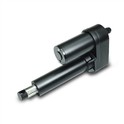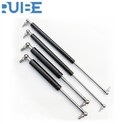As a supplier of 12V linear actuators, I understand the importance of protecting these devices from dust and debris. 12V linear actuators are widely used in various applications, such as Linear Actuator for Standing Desk, Mini Linear Actuator, and Linear Actuator for Solar Tracker. Dust and debris can significantly affect the performance and lifespan of these actuators. In this blog, I will share some effective ways to protect your 12V linear actuators from dust and debris.
Understanding the Risks Posed by Dust and Debris
Before we dive into the protection methods, it's crucial to understand the potential risks that dust and debris can bring to 12V linear actuators. Dust particles can accumulate on the moving parts of the actuator, such as the screw, nut, and gears. This accumulation can cause increased friction, which not only reduces the efficiency of the actuator but also generates more heat. Over time, the excessive heat can damage the internal components, leading to premature failure.
Debris, on the other hand, can be even more harmful. Larger debris particles can get stuck in the actuator, preventing it from moving smoothly or even causing mechanical jams. This can result in abnormal stress on the motor and other components, potentially leading to costly repairs or replacements.
Enclosure Design
One of the most effective ways to protect 12V linear actuators from dust and debris is through proper enclosure design. An enclosure acts as a physical barrier, preventing dust and debris from reaching the internal components of the actuator.
Sealed Enclosures
Sealed enclosures are the first line of defense. These enclosures are designed to have a tight seal around the actuator, preventing dust and debris from entering. When choosing a sealed enclosure, make sure it is made of a durable material that can withstand the environmental conditions of the application. For example, in outdoor applications, the enclosure should be made of weather - resistant materials such as stainless steel or high - grade plastic.
Gasket Sealing
Gaskets play a crucial role in maintaining the seal of the enclosure. They are placed around the edges of the enclosure doors or access points to prevent dust and debris from seeping in. Choose gaskets made of materials that are resistant to compression set and can maintain their elasticity over time. Silicone gaskets are a popular choice due to their excellent sealing properties and resistance to temperature variations.
Protective Covers
In addition to enclosures, protective covers can also be used to provide an extra layer of protection for 12V linear actuators.
Bellows Covers
Bellows covers are flexible covers that can expand and contract as the actuator moves. They are typically made of materials such as rubber or fabric and are designed to fit snugly around the actuator shaft. Bellows covers are effective in preventing dust and debris from adhering to the shaft, which is a common entry point for contaminants.
Boot Covers
Boot covers are similar to bellows covers but are usually made of a more rigid material. They are often used in applications where the actuator is exposed to more severe conditions. Boot covers can protect the actuator from larger debris and also provide some protection against impact.
Regular Cleaning and Maintenance
Even with enclosures and protective covers, regular cleaning and maintenance are still necessary to ensure the long - term performance of 12V linear actuators.
Cleaning Procedures
When cleaning the actuator, first turn off the power supply to avoid any electrical hazards. Use a soft brush or compressed air to remove loose dust and debris from the exterior of the actuator and its enclosure. For more stubborn dirt, a mild cleaning solution can be used, but make sure to dry the actuator thoroughly after cleaning to prevent corrosion.
Lubrication
Proper lubrication is essential for reducing friction and preventing dust and debris from adhering to the moving parts. Use a high - quality lubricant recommended by the actuator manufacturer. Apply the lubricant at regular intervals as specified in the maintenance manual.
Environmental Control
Controlling the environment where the 12V linear actuator is installed can also help in protecting it from dust and debris.

![]()
Filtration Systems
In indoor applications, installing air filtration systems can significantly reduce the amount of dust in the air. High - efficiency particulate air (HEPA) filters are particularly effective in removing fine dust particles. These filters can be installed in the ventilation system of the room where the actuator is located.
Location Selection
Choose the installation location carefully. Avoid areas where there is a high concentration of dust or debris, such as near construction sites or industrial machinery. If possible, install the actuator in a clean and dry environment.
Monitoring and Inspection
Regular monitoring and inspection of 12V linear actuators can help detect any signs of dust or debris accumulation early.
Visual Inspection
Perform visual inspections regularly to check for any signs of dust or debris on the actuator. Look for any abnormal wear or damage to the protective covers or enclosure. If any issues are detected, take immediate action to clean or replace the affected components.
Performance Monitoring
Monitor the performance of the actuator, such as its speed, force output, and power consumption. Any significant changes in these parameters may indicate the presence of dust or debris inside the actuator. If you notice any abnormal performance, stop the actuator and inspect it to identify and resolve the issue.
Conclusion
Protecting 12V linear actuators from dust and debris is essential for ensuring their reliable operation and long lifespan. By implementing proper enclosure design, using protective covers, performing regular cleaning and maintenance, controlling the environment, and conducting monitoring and inspection, you can significantly reduce the risk of dust and debris damage to your actuators.
If you are in the market for high - quality 12V linear actuators or need more information on actuator protection, please feel free to contact us for procurement and further discussions. We are committed to providing you with the best products and solutions to meet your needs.
References
- "Linear Actuator Handbook", Industry Standard Publications
- Manufacturer's manuals for 12V linear actuators
- Technical papers on actuator protection and maintenance from industry research institutions






